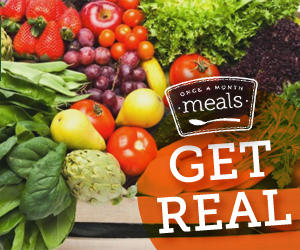**This post is part of the Get Real series. Please remember that this is meant as a learning community. We know that many of you are passionate about what you do and we want you to express that, just please do so in a way that will be an encouragement and aid to others making a transition. We want this to be a “safe space” for participants to learn. For that reason, we reserve the right to delete any comments that are not handled in this manner.
Pasta is one of the greatest things that ever happened to grains and to my taste buds! “Pasta” is an Italian word for “paste.” All pasta is made from a dough of grain flour mixed with water. There are many different shapes and sizes of pasta. While most are made from wheat, other grains can also be used on their own (for people who are gluten intolerant) or combined with wheat.
Take a dough made from grain, force it through a variety of differently shaped molds and out come nifty noodles of varying shapes — flat, smooth, solid, hollow, and twisted. Making pasta tasty with good texture and nutrition depends entirely on the flour used. Pasta made with whole-grain flours is naturally the most nutrient-dense because the bran and germ of the grain have been left intact.
The pasta you are used to seeing on the store shelves is made typically with durum wheat. Durum wheat is high in protein and gluten which makes it stick together well – perfect for the pasta to hold its shape. Most dried pasta you see is made with semolina or farina or both. These flours have had the germ and bran removed, which reduces the fiber and nutritional values. So, as with all foods, look at the labels. Here are some words to look for:
- Whole-wheat means what it says – the whole grain. Make sure it’s listed as the first ingredient and not just a marketing label on the front of the box.
- Macaroni means the pasta is made with semolina, farina, and/or flour made from refined durum wheat. Macaroni comes in many shapes: spaghetti, elbow macaroni, shells, etc.
- Egg noodles are made from flour, water, and egg (either egg white or whole eggs).
- Corn pasta has less protein than wheat pasta, but it is more easily digested by gluten-sensitive persons.
- Multi-grain pasta adds dense grains, such as amaranth, quinoa, or flour from soy to wheat flours to make the pasta richer in protein.
- Rye pasta is also known as “spelt” and is particularly high in protein, fiber, zinc, and iron. (However, it is not made from spelt just for clarification.)
- Flavored pasta includes vegetables, such as spinach and tomato, to add taste, variety, and nutrition to plain old pasta.
- Couscous is a cross between grain and pasta. It is made from cooked and dried semolina. The tiny grains are cooked like rice, absorbing all the cooking liquid.
- Soba Noodles are tasty, thin Japanese noodles made with buckwheat, which isn’t wheat, but it’s usually blended with wheat so not gluten-free.
- Udon Noodles are thick Japanese wheat noodles that hold up well in soups.
- Use a big enough pot. Pasta can expand up to three times its original size so give it room!
- Don’t skimp on water. Use at least 2 quarts of water for each 1/2 pound of pasta.
- Stir it often so the pasta does not stick together.
- Check to make sure your pasta is cooked early and often. Basically, you want the pasta to feel firm and slightly springy when you bite into it. If it sticks to your teeth when you chew it, it’s not ready. And don’t throw it against the wall or your fridge, while fun and entertaining, it won’t let you know they are done. Pasta will continue cooking after it’s drained.
- Do not rinse the pasta after it has been drained. The pasta water helps the sauces and flavors stick to the noodles.
March Week One Action Item:
- Make one of your favorite pasta dishes (or peruse some of ours) and use whole wheat noodles. Can’t go 100% whole wheat? Try the dish with half whole wheat, half regular, and see what you think!
- Headed out to your favorite Italian restaurant this week? Ask them what grains they use in their pasta, and simply ask if there’s a whole wheat option! You never know what you can get.
March Get Real:
Please take a moment to thank our guest authors by clicking over to their sites and/or liking them on Facebook and/or Twitter.
Sponsor: Once A Month Meals– One pledged Get Real participant will be winning some pasta making tools packet. ***This giveaway is now closed.***